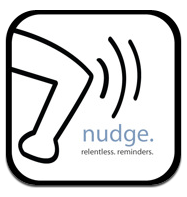

Puzzles require visual acuity, spatial awareness, and some degree of planning. A lot of our students are less than fond of puzzles because of their weaknesses in visual and spatial skills. These students may also have difficulty with Handwriting, Math Concepts (Geometry or anything picture/space-based), and Organization (of thoughts and materials). The good news is that games and puzzles that build visual and spatial skills can be very helpful for these students.
Many of the classic games parents and professionals have used for decades (if not centuries in the case of Tangrams) have been adapted into APPS for the twenty-first century. I explored a variety of twists on the classic “Tangram” and “Pentaminoes” puzzles; where you have to manipulate shapes to get them to fit exactly into a larger shape. I only tried the LITE (FREE) versions – here are some of my favorites:
Tangrams
1.) Tangrams Lite 
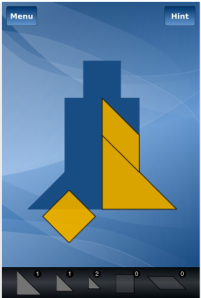 Pros: This is a simple, no frills Tangrams puzzle. The goal is to fill in the template with the shapes provided. The blocks are only one color, but they are easy to rotate 45 degrees at a time with a tap. Hints are available.
Pros: This is a simple, no frills Tangrams puzzle. The goal is to fill in the template with the shapes provided. The blocks are only one color, but they are easy to rotate 45 degrees at a time with a tap. Hints are available.
Cons: This was initially designed for iPhone, so on an iPad it’s slightly blurred. There is a glitch when you slide pieces off the board and they disappear completely. When that happens, you have to “Reset the Puzzle.”
2.) Tazzle Lite 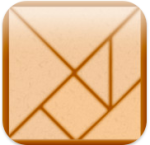

Pros: This is very similar to Tangrams Lite. The interface is simple, and there is a satisfying noise when the piece fits into place. Instead of tapping the piece you tap a wheel in the corner of the screen to rotate the shape 45 degrees. In the free version, there are 40 levels. The shapes look harder, but they’re actually simpler to match because there are less combinations to try.
Cons: More ads than Tangrams Lite. No hints. The music can get a little annoying.
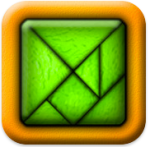 3.) TanZen Lite
3.) TanZen Lite

Pros: This is the trickiest of the Tangram APPs I tried because you freely rotate the pieces around by dragging your finger around the outside ring. This means that there are no fixed degrees that the pieces stop at. If your student does not have strong fine motor skills or is not adept on the iPad, I would NOT use this APP. However, if you are trying build those skills – this APP could be great. Because of the precision needed, this APP most closely resembles actually playing with Tangram puzzle pieces. 54 free, interesting puzzles. Hints available. Relaxing music plays in the background.
Cons: Difficult and frustrating for students with fine motor challenges.
Metacognitive Strategies for Tangrams:
- Is there any place where ONLY one shape can fit? Put that shape in first.
- Then, try fitting the biggest pieces.
- Remember that you can rotate – try rotating the shape while it’s on top of the blank template to see how it could fit in.
Pentaminoes
1.) Doodle Fit Free 

Pros: I love Doodle Fit. I think the graphics are simple yet interesting (they mimic the design of the popular game, Doodle Jump – and are meant to look like “doodles” in a notebook). When you drag a piece onto the template, the template glows a bit to show how the piece would fit before you drop it. Then, once you drop it, it changes a fun color (from black). The pieces can not be rotated, so it limits the options and really makes you think. There’s around 40 levels in the free version. Hints are available. There are multiple ways to solve each puzzle – it even tells you how many ways there are AND how many you’ve found.
Cons: Before dragging the pieces, they are on a smaller scale, which might make this a little more challenging for some students. Ads do pop up and show up at the top of the screen. The music gets a little annoying as well.
 2.) Pentofill
2.) Pentofill
Pros: This is a very simple, relatively easy to use, colorful APP. You can flip the shapes by tapping (and if you’re dexterous on the iPad, you can also rotate them using 2 fingers). Hints available. 30 levels.

Cons: These puzzles can be really HARD. The shapes you are trying to create are squares and rectangles so there are relatively few clues to go off of. This APP was made for iPhone, so it’s on a smaller scale than iPad APPS.
3.) Brain Fit 
Pros: Unlike the other Pentaminoes games, this game doesn’t involve rotating pieces at all and isn’t really made of pentaminoes (shapes made of 5 square blocks). It’s about moving the pieces in the correct order so that they can all fit. You can concentrate on minimal moves and
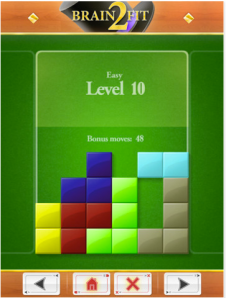 doing in quickly once you get the hang of the puzzle. There’s 90 levels (Easy, Medium, Hard) and it keeps track of your previous scores. It’s very user-friendly and gives an “Improved Result” trophy graphic if you do better than your previous time/# of moves.
doing in quickly once you get the hang of the puzzle. There’s 90 levels (Easy, Medium, Hard) and it keeps track of your previous scores. It’s very user-friendly and gives an “Improved Result” trophy graphic if you do better than your previous time/# of moves.
Cons: Ads at the top. Could be frustrating to students who are used to being able to manipulate/rotate the pieces.
Metacognitive Questions to Ask During Pentaminoes:
- Which block are you going to try first? Why?
- Have you tried that before?
- Are you thinking about doing it accurately OR quickly?
- Can you rotate the pieces? How?
- If you’re frustrated you can always clear the board, and start from scratch (“wipe the board clean”) with a different approach.
- Geoboards
- Pattern Blocks
- Pentominoes
- Tangrams















 doing in quickly once you get the hang of the puzzle. There’s 90 levels (Easy, Medium, Hard) and it keeps track of your previous scores. It’s very user-friendly and gives an “Improved Result” trophy graphic if you do better than your previous time/# of moves.
doing in quickly once you get the hang of the puzzle. There’s 90 levels (Easy, Medium, Hard) and it keeps track of your previous scores. It’s very user-friendly and gives an “Improved Result” trophy graphic if you do better than your previous time/# of moves.